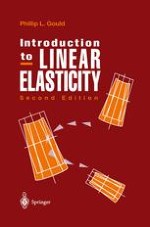"Elasticity is one of the crowning achievements of Western culture!" ex claimed my usually reserved colleague Professor George Zahalak during a meeting to discuss the graduate program in Solid Mechanics. Although my thoughts on the theory of elasticity had not been expressed in such noble terms, it was the same admiration for the creative efforts of the premier physicists, mathematicians and mechanicians of the 19th and 20th centuries that led me to attempt to popularize the basis of solid mechanics in this introductory form. The book is intended to provide a thorough grounding in tensor-based theory of elasticity, which is rigorous in treatment but limited in scope. It is directed to advanced undergraduate and graduate students in civil, mechani calor aeronautical engineering who may ultimately pursue more applied studies. It is also hoped that a few may be inspired to delve deeper into the vast literature on the subject. A one-term course based on this material may replace traditional Advanced Strength of Materials in the curriculum, since many of the fundamental topics grouped under that title are treated here, while those computational techniques that have become obsolete due to the availability of superior, computer-based numerical methods are omitted. Little, if any, originality is claimed for this work other than the selection, organization and presentation of the material. The principal historical con tributors are noted in the text and several modern references are liberally cited.
